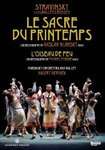|
Back
08/28/2013
Igor Stravinsky: L’Oiseau de feu – Le Sacre du printemps (*)
Ekaterine Kondaurova (L’Oiseau de feu), Ilya Kuznetsov (Ivan Tsarevitch), Marianna Pavlova (La Princesse), Vladimir Ponomarev (Kachtcheï l’immortel/Le sage*), Alexandra Iosifidi (L’Elue*), Elena Bazhenova (La Vieille*), The Mariinsky Orchestra and Ballet, Valery Gergiev (conductor), Michael Fokine, Vaslav Nijinsky*(choreographers), Isabelle Fokine, Andris Liepa, Millicent Hodson* (choreographic reconstruction), Alexander Golovin, Léon Bakst, Nicholas Roerich* (set and costume design), Anna and Anatoly Nezhny, Kenneth Archer* (set and costume reconstruction), Denis Caïozzi (video director)
Live performances from the Mariinisky Theatre (June, 2008) – 85’ (ballets) plus 38’ (extras)
BelAir classiques BAC241 – Illustrated booklet in English, French and German

   
This DVD is a major piece of eye-candy in addition to a sonic treat thanks to orchestral performances of extreme sensuousness and incisive drama under Valery Gergiev. Both performances capture the dazzling brilliance of Serge Diaghilev’s Ballets Russes at two of the legendary company’s peak moments.
The performance of L’Oiseau de feu (“The Firebird”) is a reconstruction of Michel Fokine’s production of 1910 by the choreographer’s grand-daughter, Isabelle Fokine, and noted dancer Andris Liepa. This was the piece that put Stravinsky in the public spotlight, and it was soon followed by Pétrouchka (1911) and Le Sacre du printemps (1913). The story contained in the work doesn’t come across as anything all that gripping (something about a magic feather and a pair of royal lovers harassed by a very evil ogre-type), but the marvelous look of the piece, the riveting performance of Ekaterina Kondaurova in the title role, and the orchestral playing add up to a wonderful experience.
Equally dazzling for sheer spectacle is Le sacre du printemps in Millicent Hodson’s reconstruction of Vaslav Nijinsky’s neo-primitive choreography. Everyone by now must know about the riot caused by the combination of Stravinsky’s driving music and Nijinsky’s seemingly perverse choreography which had taken the dancers 120 hours of rehearsals to come to terms with. The date was May 29, 1913, and for many it marks the real start of the 20th century. Nijinsky’s work was only performed eight times. Many choreographers have tackled it since (this past spring the Polish National Ballet presented and evening of three versions of the work, none of them the Nijinsky/Hodson) and Stravinsky’s orchestral work has become a firm part of the repertoire of every orchestra. Maestro Gergiev and his orchestra give a gripping performance; the final section of the first tableau (“Dance of the earth”) is truly cataclysmic. Especially in this section the dance demands repeated viewings; as Millicent Hodson explains in the accompanying interview, each of the 44 members of the corps has a specific part to perform - just one example of Nijinsky’s departure from traditional practice.
There are just three solo roles in the work. Alexandra Iosifidi is l”Élue (“The Chosen One”) which is a rather passive for a central role. (I find Pina Bausch’s version gives more scope to the part.) The other two are Elena Bazhenova as La Vieille (“The 300 -year-old Woman” in English-language programs) and Vladimir Ponomarev as Le Sage (“The Wise Elder”), each delivered in full characterful form.
Beside the ballets, extras include an 8-minute history of the Ballets Russes with a focus on Vaslav Nijinsky (in French with English titles) and a 30-minute interview with husband and wife team Millicent Hodson and Kenneth Archer (in English with French titles). The two met when she was researching Nijinsky’s lost choreography and he was researching the works of Nicholas Roerich, the designer of Le Sacre and co-author, along with Stravinsky, of its scenic plan. Hodson outlines how she reconstructed Le Sacre. Of vital importance was Marie Rambert, Nijinsky’s assistant at the time, who made detailed notes and sketches. Hodson was lucky to meet with Rambert (1890-1982) near the end of her long life. Hodson also used reviews of the work - the negative reviews were of more use (perhaps they tended to single out what exactly seemed wrong.) Her reconstruction was premiered by the Joffrey Ballet in 1987 and has since been set on 11 other companies. Not all critics are enamoured of her reconstruction, but one must acknowledge that, with Kenneth Archer’s reconstruction of the designs, the total effect delivers the surprise (and shock) experienced by the first audiences despite of all the subsequent dance and musical innovation we have seen in recent decades. While many choreographers have attempted the work, this IS the closest we have to the original.
If you’re an aficionado of Diaghilev’s Ballets Russes you will want to experience this dazzling DVD. The booklet is beautifully illustrated too. If you aren’t yet bitten by the Diaghilev bug this just might do it.
Michael Johnson
|